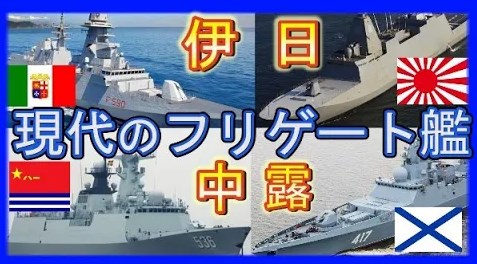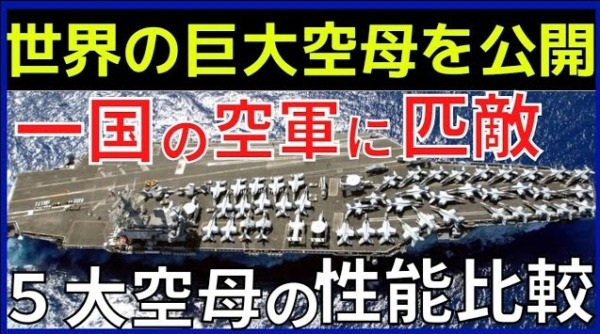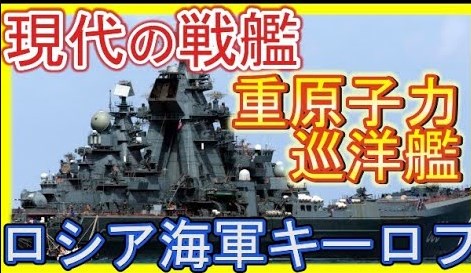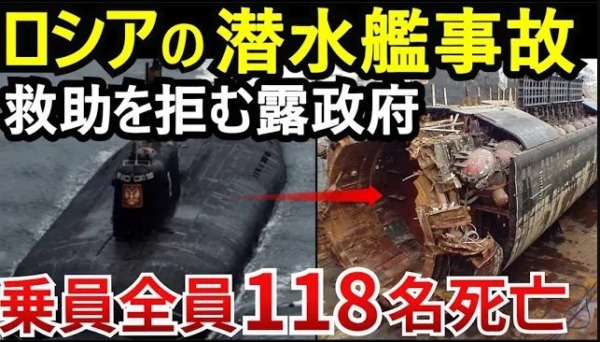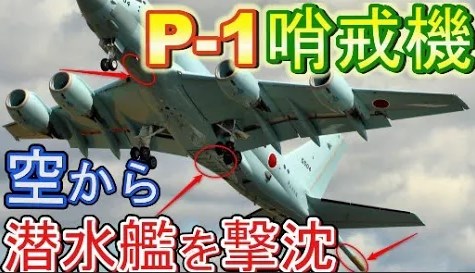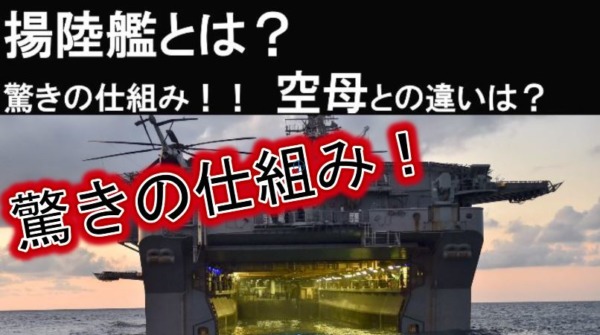
Amazonのオーディオブック12万タイトルの本を好きなだけお楽しみいただけます。・本の1冊分の月額で聴き放題
・料金をメリットが上回る
・いつでも読書できる
・読書量が格段に増え、積読が解消される
・長時間の読書も目が疲れない
・聴くたびに学びを感じる

This article is available in English.
Please scroll below the Japanese article to see the English version.
揚陸艦の主な任務は、海上から海岸に海兵隊や車両を上陸させることである。
占領された島を奪還し、そこに居座ることが最終的な目的でもある。
それを行うのが海兵隊や陸軍の任務であり、彼らの足となるのが揚陸艦の役目である。
映画などで、浜辺から多くの兵隊や水陸両用車などが上陸していくシーンを見たことがある人もいるだろう。
また第二次世界大戦では、硫黄島をめぐり米軍の揚陸部隊が数多く上陸した。
今回は、揚陸艦と空母の違い、3タイプの揚陸艦とその任務、驚くべき内部構造に迫ってみた。

揚陸艦の仕組みを動画でも解説したので見てね♪
この記事に書かれている内容は
日本が開発!揚陸艦の始まりとは?

揚陸艦といえばアメリカ海軍のイメージが強いが、実は日本も1929年に「大発」(だいはつ)と呼ばれた小型の揚陸艇を開発していた。
「大発」は海岸に直接乗り上げ、前部のハッチを開いて兵隊を上陸させるというものであった。
この「大発」の戦法に衝撃を受けたアメリカ、イギリスは、第二次世界大戦時に、揚陸艇LSTを開発することとなり、日本の「大発」と同様の上陸方法で兵隊や車両を上陸させた。

しかしLSTは人員や車両を運搬するためのものであり、長距離を航海することはできなかったため、敵地の沖までは輸送船で運搬し、クレーンで海上に下ろすという効率の悪い方法で運用していた。
また、作業中に敵の攻撃をうける恐れもあったことから、専用の大型揚陸艦が開発されていくこととなる。
現在のアメリカ海軍の揚陸艦と種類
現在の揚陸艦はかなりサイズも大きくなったため、昔のように直接浜辺に乗り上げるようなものではなく、沖に漂泊した状態で運用する。
アメリカ、イギリス、フランス、スペインなどが保有しているのが、ドック型揚陸艦である。
船体は数万トンクラスで、艦橋が片側によっており、全通甲板なのでパッと見は空母に良く似た形をしているが、戦闘機を強制的に加速させるカタパルトはなく、艦尾に大きなハッチがあるのが空母との違いだ。
現在、世界最大の揚陸艦がアメリカ海軍の「ワスプ級」で、スペックはこのようになっている。
・全長258m 幅43m
・満載排水量41302トン、
・標準搭載機ヘリコプター×30機
・攻撃機6~8機
・乗員1123名
・揚陸部隊 1687名
航空機は主に、垂直離発艦できるSTOVL(ストーブル)航空機とヘリコプター、オスプレイなどがメインで運用され、艦尾のハッチを開くと、LCAC(エルキャック)と呼ばれるホバークラフトや海兵隊を運ぶLCUなどを収容することが可能だ。
揚陸艦の種類は大きく分けると強襲揚陸艦、ドック型揚陸艦、ドック型輸送揚陸艦の3つに分類される。
それぞれの特徴を解説していこう。
強襲揚陸艦(ワスプ級)
1989年7月に就役したワスプ級強襲揚陸艦は現在も世界最大サイズである。
1989年から2009年の間で8隻が就役した。LCAC(エルキャック)と呼ばれるホバークラフトとヘリコプターの機動性により、海岸から50マイル(約90km)沖から上陸作戦が行える。

また、敵の脅威が高い場合はヘリコプターを戦闘機に変え 20 を搭載することができ、補助空母としても運用できる。
また洋上給油機能を備えており、他の艦艇に燃料を補給することもできる。

艦尾のハッチを開きドックに小型艇やなどを収容可能であり、ドックのサイズは長さ 81.5m幅、15.3mでLCACを3隻収容できるサイズだ。
ドック型揚陸艦(ホイッドビーアイランド級)
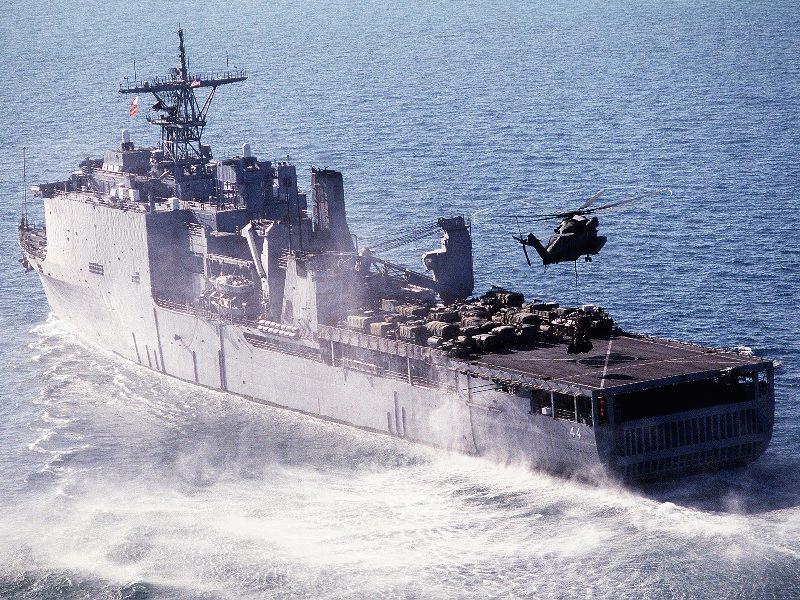
1852年2月に就役した「ホイッドビー・アイランド」は計画当時からLCACの運用を考慮しており、1985年から1998年の間で12隻が就役した。
1番艦から8番艦までのドックの長さは 134.1m 幅 15.2mとなっておりLCAC4隻、もしくは41mのLCU を3隻収容できる能力がある。
9番艦から12番艦までは、貨物輸送能力を大幅に向上したためドック内の容量が狭くなっており、搭載LCACが半数の2隻に減っている。
![LCAC leaving the well deck of the Whidbey Island-class dock landing ship USS Germantown (LSD-42), Okinawa, Okinawa, June 27, 2011 [2144×1424] : MilitaryPorn](https://external-preview.redd.it/LLNFrkn_5-0J42jr4sGydN9Z_EPl3949JWEpus0muIc.jpg?auto=webp&s=d8191133390bf9f26a5516ded0e6ef3d95ae84e2)
ドック内に海水を入れることで、LCU などを発進させる作りであるが、バラストタンクに海水を貯めることで艦尾を下げ、海水を引き込む仕組みである。

ホイッドビー・アイランド級もすでに古く最後の12番艦が1998年に就役している。
その代わりとして登場したのが、次に解説するサンアントニオ級である。
ドック型輸送揚陸艦(サンアントニアオ級)
2006年1月に就役したのが、初のステルス設計が採用されたサンアントニオ級である。
現在までに10隻以上が就役しており、目を引くのが、その特徴的な形のマストだろう。
従来のマストとは明らかに違った形状をしており、ステルス性を考慮した形となっている。
4番艦グリーンベイは2020年現在佐世保に配備されており、このクラスでは初めての海外配備となる。
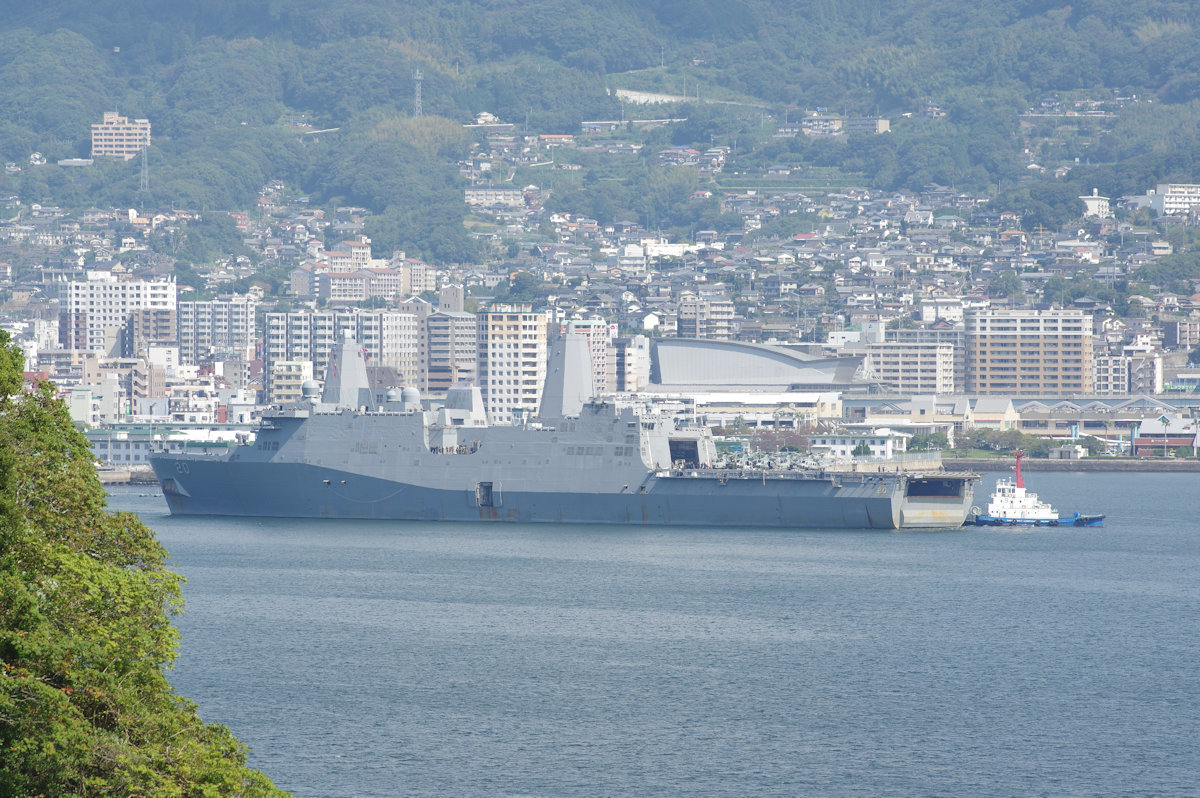
また、5番艦ニューヨークの船体には、9,11で倒壊した世界貿易センタービルの資材が一部使用されている。
艦尾のハッチは上下に分かれて開くタイプとなっており、ドック内にはLCACが2隻搭載可能だ。
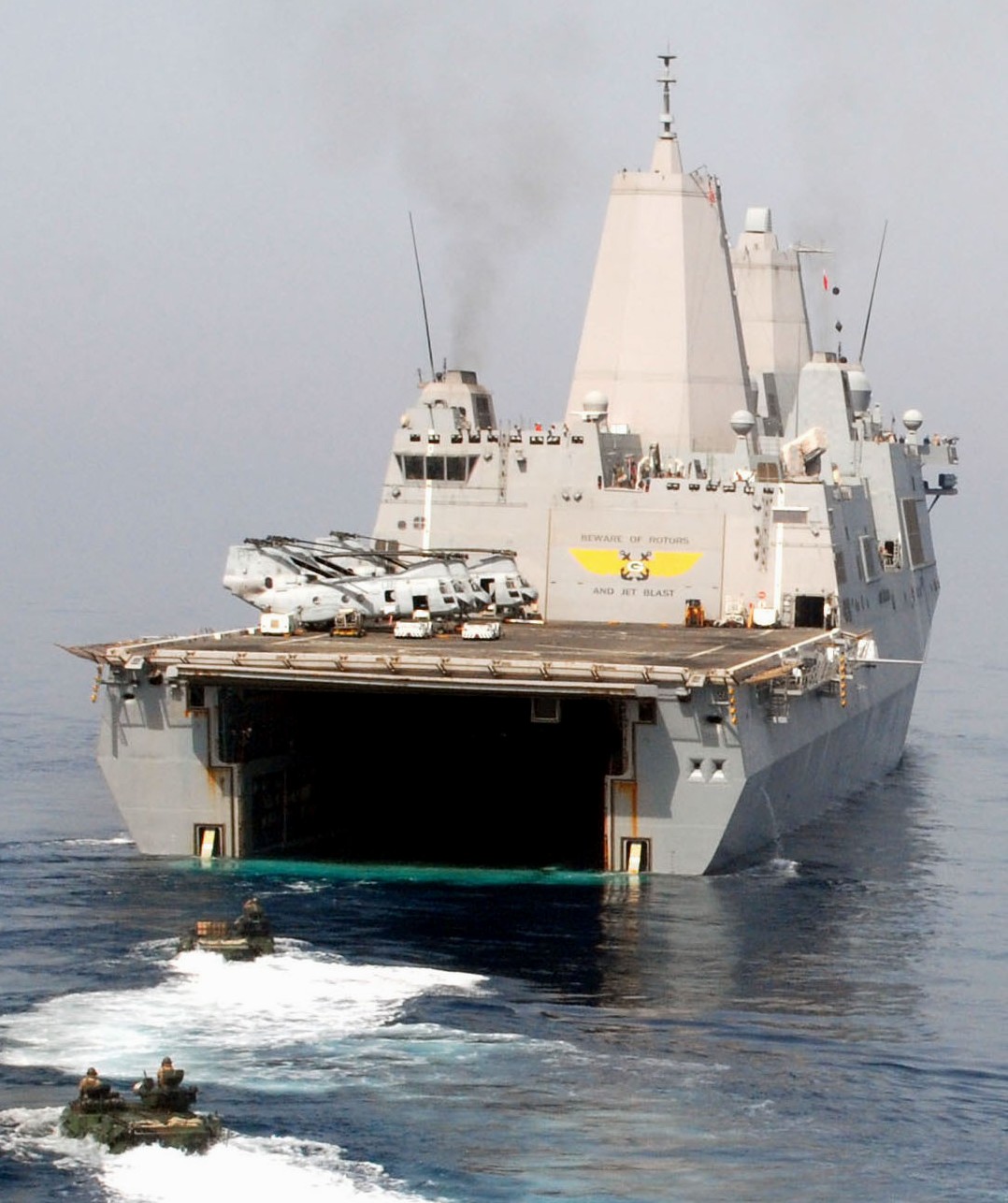
艦尾のハッチにも段差がつけられており、徹底したステルス性となっている。
揚陸部隊の編成 ESG とは?
![DVIDS - Images - Wasp Up-Gunned ESG Formation [Image 20 of 124]](https://cdn.dvidshub.net/media/thumbs/photos/1804/4315720/1000w_q95.jpg)
揚陸艦は空母と同じくそれ自体に特別な戦闘力はないため、イージス艦などの随判艦とともに作戦を遂行することとなる。
空母は CSG(キャリアストライクグループ)と呼ばれる空母打撃群で行動するのに対し、揚陸艦は ESG(エクスペディショナリーストライクグループ)という遠征打撃群で行動する。
エクスペディショナリーとは遠征を意味する。
ESG の基本編成は次のようになっている
強襲揚陸艦(LHALHD)×1
ドック型揚陸艦(LSD)×1
ドック型輸送揚陸艦(LPD)×1
ミサイル巡洋艦(CG)×1タイコンデロガ級イージス艦
ミサイル巡洋艦(DDG)×2アーレイバーク級イージス艦
攻撃型原子力潜水艦(SSN) ×1
CSG の場合グループに対し空母は1隻だが、ESG は先ほど解説した3タイプの揚陸艦が1つのグループに所属することとなる。
その理由は、各タイプ別にメリット、デメリットがあるからだ。
まず、多くの航空機を運用ができるのは強襲揚陸艦(LHA・LHD)だけであり、現場での迅速な展開や機動力が強みになる。
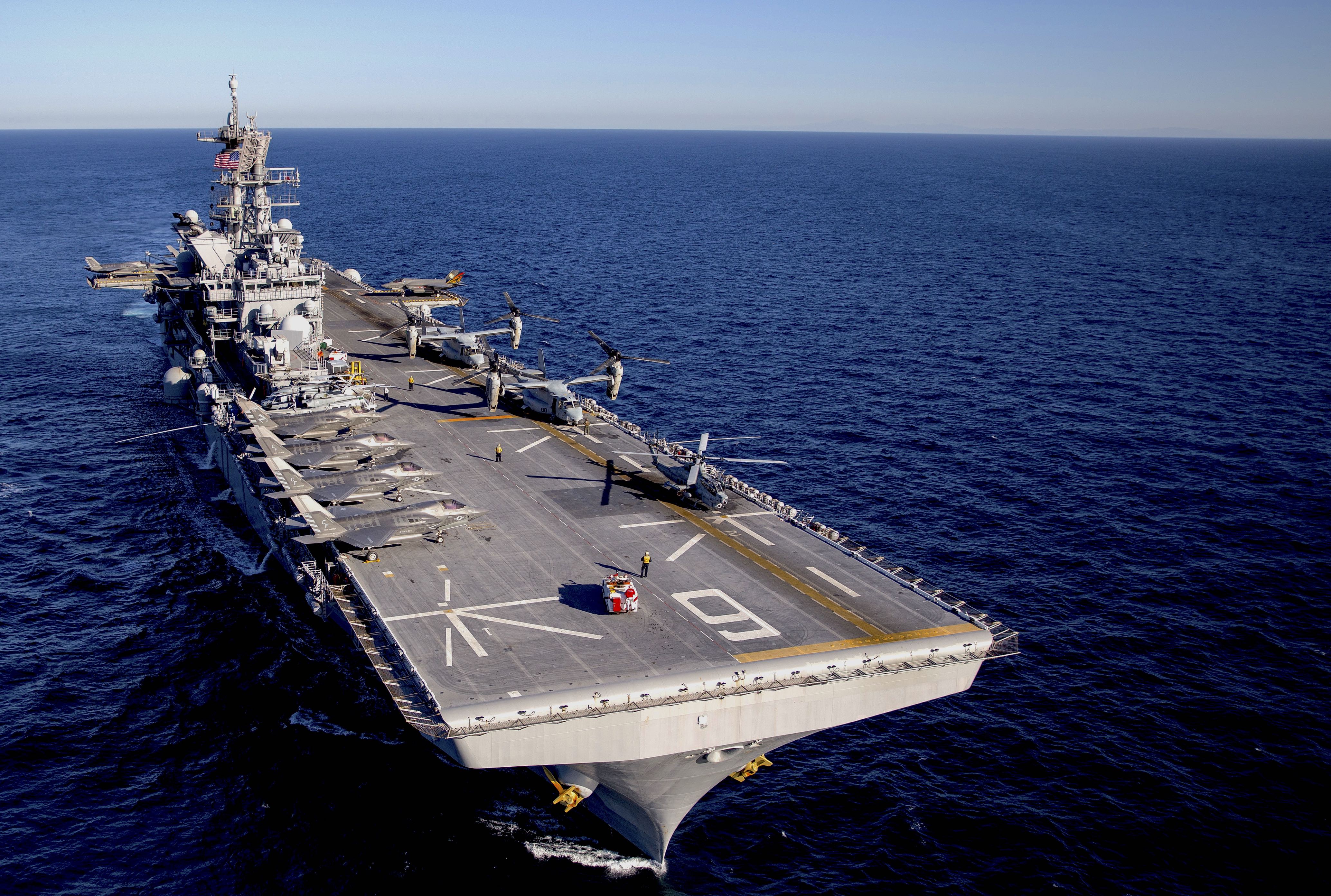
一方、車両の運搬能力はドック型揚陸艦のほうが優れている。
航空機用の格納庫がないため、その分多くの車両を搭載できる。

また、サンアントニアオ級ドック型輸送揚陸艦(LPD)は指揮系統が他の艦よりも優れており、充実した施設を備えているが、搭載能力を重視しているため、ドック内のスペースが狭く揚陸艇の数が少ない。
それをカバーするのが、ドック型揚陸艦(LSD)でドックが広く揚陸艇も多く搭載できる。
このように、3つのタイプの揚陸艦はそれぞれの強みを生かし、弱点を補うことでグループを形成しているのだ。
このように米海軍では揚陸艦を1980年代から運用し、訓練を続けてきた。
では、わが国日本はどうなのだろうか?
日本の揚陸部隊 水陸機動団
引用:https://motor-fan.jp/article/10011645
日本の自衛隊は 2018年3月に佐世保の相浦(あいのうら) 駐屯地にて水陸機動団が編成され、アメリカ海兵隊と共同訓練を行い、初の海外での上陸訓練も行われた。
現在2個連隊で定員は2100名であるが3個連隊が完成すると3000人規模の部隊となる。
近年、中国が南西諸島の領海侵犯を繰り返し、挑発的な行動を続けているが、有事の際には水陸機動団が島嶼(とうしょ)奪回のために作戦を遂行しなければならない。
AAV7 という戦闘装甲車両は水陸両用で水中に浮上する能力があり、ウォータージェットの力で進むことができ地上で72km/h、水上で13km/hの速度を出すこと可能である。
沖合の揚陸艦から目標の海外を目指し発進し、上陸後に隊員たちを降ろし、作戦を決行するという流れである。
日本も中国の脅威に対処すべく、着実に水陸両用作戦の強化を行っているが、まだ歴史も浅く経験も少ないため、これらの活躍に期待したい。
The difference between an Amphibious warfare ship and an aircraft carrier is THIS!

The main task of the Amphibious warfare ship is to land Marines and vehicles from the sea to the shore.
The ultimate goal is to recapture the occupied island and stay there.
It is the mission of the Marines and the Army to do that, and it is the role of the Amphibious warfare ships to be their feet.
You may have seen many soldiers and amphibious vehicles landing on the beach in movies.
In World War II, many US military landing units landed over Iwo Jima.
In this video, I examine the differences between Amphibious warfare ships and aircraft carriers, three types of Amphibious warfare ships, their missions, and their amazing internal structure.
Developed in Japan! What is the beginning of the Amphibious warfare ship?
The image of US Navy Amphibious warfare ships is strong, however Japan also developed a small Amphibious warfare ship called “Daihatsu” in 1929.
The “Daihatsu” was able to land directly on the shore, open the front hatch, and land the soldiers.
The United States and Britain were shocked by this “Daihatsu” tactic, and decided to develop the Amphibious warfare ship “LST” (Landing Ship, Tank) during World War II, and landed soldiers and vehicles in the same way as Japan’s “Daihatsu”.
However, since LST is for transporting personnel and vehicles and could not sail long distances, it is operated by an inefficient method of transporting it by a transport ship to the enemy shoreline and lowering it to the sea with a crane.
In addition, there was a risk of being attacked by the enemy during this process, so a dedicated large Amphibious warfare ship had to be developed.
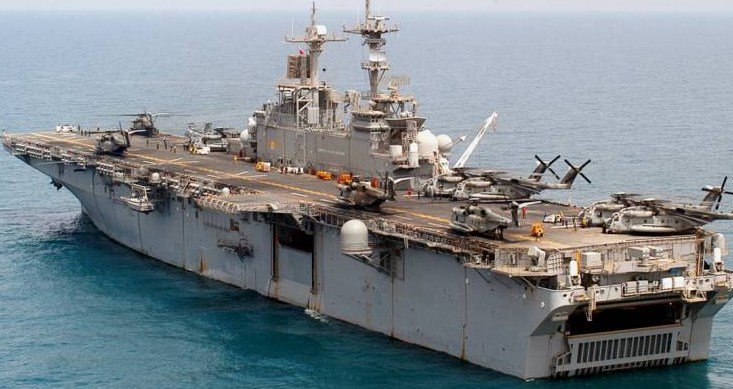
Since the size of the current Amphibious warfare ship has increased considerably, it does not ride directly on the beach as it used, but is operated while drifting offshore.
Dock Amphibious warfare ships are owned by the United States, Great Britain, France, Spain, etc.
The hull is in the tens of thousands of tons class, the bridge is on one side, and since it is a full deck, it looks like an aircraft carrier at first glance, but the difference from the aircraft carrier is that there is no catapult that forcibly accelerates the fighter jet, and has a large hatch on the stern.
Currently, the world’s largest Amphibious warfare ship is the US Navy’s “Wasp-class”, with specifications like this.
Wasp-class specs
・ Overall length 258m Width 43m
・ Full load displacement 41302 tons,
・ Standard equipped helicopter x 30
・ 6-8 attack aircraft
・ 1123 crew members
・ Landing unit 1687 people
The aircraft are mainly STOVL aircraft that can take off vertically, helicopters, Osprey, etc., and when the stern hatch is opened, it is possible to house hovercraft called LCAC and LCUs that carry the Marine Corps.
The types of Amphibious warfare ships are roughly classified into three types: Amphibious Assault ships, Amphibious Dock Landing ships, and Amphibious Transport Dock ships.
I will now explain each ship and its features.
Amphibious Assault ship (Wasp-class)
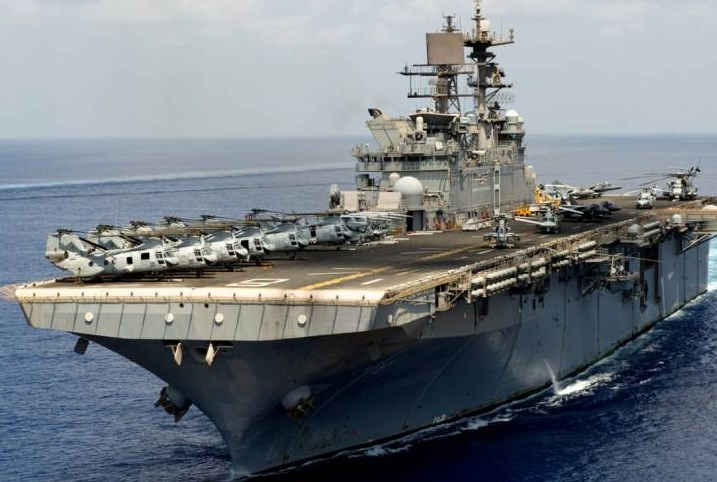
The Wasp-class amphibious assault ship commissioned in July 1989, and is still the largest in the world.
Eight vessels were commissioned between 1989 and 2009. Due to the mobility of hovercraft and helicopters called LCAC, landing operations can be carried out 50 miles (about 90 km) off the coast.
Also, if the threat of the enemy is high, the helicopter can be converted into a fighter and equipped with 20, and it can also be used as an auxiliary aircraft carrier.
It also has an offshore refueling function and can re Amphibious Dock Landing ship (Whidbey Island-class)fuel other ships.
The hatch on the stern can be opened to accommodate small boats and the like in the dock. The size of the dock is 81.5m long and 15.3m wide and can accommodate three LCACs.
Amphibious Dock Landing ship (Whidbey Island-class)
The Whidbey Island, commissioned in February 1852, has been considering LCAC operations since its planning, with 12 vessels commissioned between 1985 and 1998.
The length of the docks from ships 1 to 8 is 134.1m wide and 15.2m wide, and she is capable of accommodating four LCACs or three 41m LCUs.
From the 9th ship to the 12th ship, the capacity in the dock has been reduced due to the significant improvement in cargo transportation capacity, and the number of LCACs installed has been reduced to two, which is half.
By putting seawater in the dock, the LCU etc. are started, but by storing seawater in the ballast tank, the stern is lowered and seawater is drawn in.
The Whidbey Island-class is already old and the last 12th ship was commissioned in 1998.
To replace Whidbey Island-class ships, the San Antonio-class was created, which will be explained next.
Amphibious Transport Dock ship (San Antonio-class)
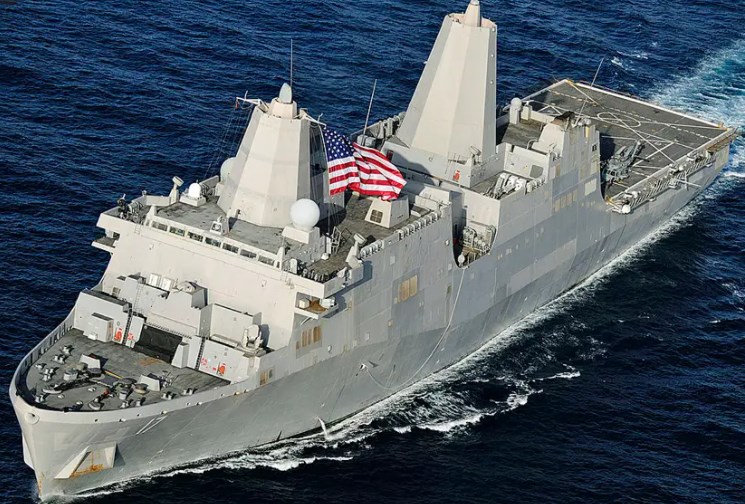
Commissioned in January 2006 is the San Antonio-class, which adopted the first stealth design.
To date, more than 10 vessels have been commissioned, and what is striking is the mast of its characteristic shape.
It has a shape that is clearly different from the conventional mast, and has a shape that takes stealth into consideration.
The fourth ship, Green Bay, has been deployed in Sasebo as of 2020, making it the first overseas deployment in its class.
In addition, some materials from the World Trade Center Building, which collapsed on 9/11, are used in the hull of the 5th ship, New York.
The hatch on the stern is a type that opens vertically, and two LCACs can be installed in the dock.
The hatch on the stern is also stepped, giving it a thorough stealth.
What is the formation of landing units ESG?
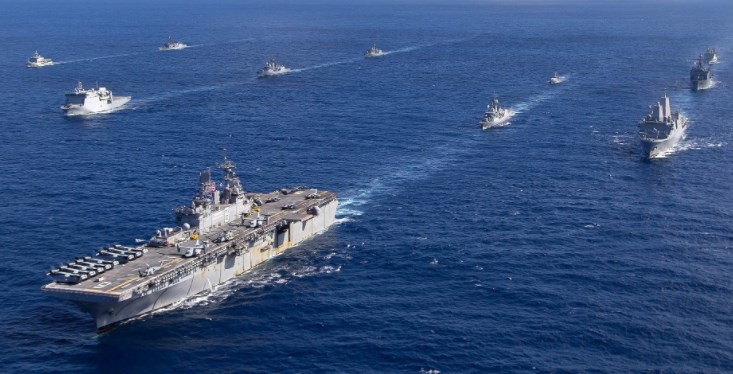
Amphibious warfare ships, like aircraft carriers, do not have any special combat power in their own right, so they will carry out operations with Aegis ships and other warfare ships.
Aircraft carriers operates in a Carrier Strike Group or “CSG”, while Amphibious warfare ships operate in an Expeditionary Strike Group or “ESG”.
Expeditionary means an expedition.
The basic organization of ESG is as follows.
ESG organization
Amphibious assault ship (LHAL HD) x 1
Dock Amphibious warfare ship (LSD) x 1
Dock Amphibious warfare ship (LPD) x 1
Missile Cruiser (CG) x 1 Ticonderoga-class Aegis Ship
Guided Missile Cruiser (DDG) x 2 Arleigh Burke-class Aegis Ship
Attack-type nuclear submarine (SSN) x 1
In the case of CSG, there is one aircraft carrier for each group, but in ESG, the three types of Amphibious warfare ships explained earlier belong to one group.
The reason is that each type has its advantages and disadvantages.
First of all, only amphibious assault ships (LHA / LHD) can operate many aircraft, and their strengths are rapid deployment and mobility at the site.
On the other hand, the dock Amphibious warfare ship has better vehicle carrying capacity.
Since there is no hangar for aircraft, more vehicles can be loaded.
In addition, the San Antonio-class dock Amphibious warfare ship (LPD) has a better command system than other ships and has abundant facilities, but because it emphasizes loading capacity, the space inside the space inside the dock is narrow and the number of landing crafts it can hold is small.
To cover this is the dock Amphibious warfare ship (LSD), which has a wide dock and can carry many landing crafts.
In this way, the three types of Amphibious warfare ships form a group by taking advantage of their respective strengths and compensating for their weaknesses.
In this way, the US Navy has been operating and training Amphibious warfare ships since the 1980s.
So what about Japan?
Japanese landing force: the Amphibious Rapid Deployment Brigade

In March 2018, the Japanese Self-Defense Forces formed the Amphibious Rapid Deployment Brigade at the Ainoura Garrison in Sasebo, and conducted joint training with the US Marine Corps, and conducted its first overseas landing training.
Currently, there are two regiments with a capacity of 2,100 people, but when the third regiment is completed, it will be a unit of 3,000 people.
In recent years, China has repeatedly invaded the territorial waters of the Nansei Islands and has continued to take provocative actions. In the event of an emergency, the Amphibious Rapid Deployment Brigade must carry out operations to recapture the islands.
The AAV7 combat armored vehicle is amphibious and capable of ascending into the water, capable of traveling with the power of water jets and capable of speeds of 72km/h on the ground and 13km/h in the water.
It carries out its operation as an offshore Amphibious warfare ship aiming for the target across the sea, then unloads the troops after landing.
Japan is also steadily strengthening amphibious operations in order to deal with the threat of China, but since it has a short history and little experience, I look forward to their future endeavors.
Amazonのオーディオブック12万タイトルの本を好きなだけお楽しみいただけます。・本の1冊分の月額で聴き放題
・料金をメリットが上回る
・いつでも読書できる
・読書量が格段に増え、積読が解消される
・長時間の読書も目が疲れない
・聴くたびに学びを感じる


